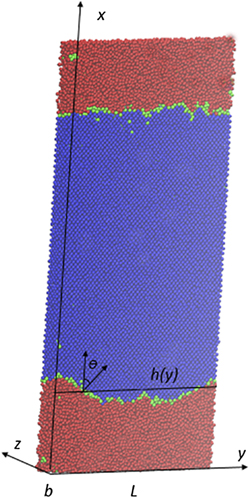Crossref Citations
This article has been cited by the following publications. This list is generated based on data provided by
Crossref.
Wu, L.K.
Li, C. L.
Xu, B.
Li, Q.L.
and
Liu, W.
2016.
TMS 2016: 145thAnnual Meeting & Exhibition: Supplemental Proceedings.
p.
359.
Wu, L. K.
Li, C. L.
Xu, B.
Li, Q. L.
and
Liu, W.
2016.
TMS 2016 145th Annual Meeting & Exhibition.
p.
359.
Kaptay, George
2018.
On the solid/liquid interfacial energies of metals and alloys.
Journal of Materials Science,
Vol. 53,
Issue. 5,
p.
3767.
Xu, Yijiang
Zhao, Dongdong
and
Li, Yanjun
2018.
A Thermodynamic Study on the Effect of Solute on the Nucleation Driving Force, Solid–Liquid Interfacial Energy, and Grain Refinement of Al Alloys.
Metallurgical and Materials Transactions A,
Vol. 49,
Issue. 5,
p.
1770.
Abdeljawad, Fadi
Foiles, Stephen M.
Moore, Alexander P.
Hinkle, Adam R.
Barr, Christopher M.
Heckman, Nathan M.
Hattar, Khalid
and
Boyce, Brad L.
2018.
The role of the interface stiffness tensor on grain boundary dynamics.
Acta Materialia,
Vol. 158,
Issue. ,
p.
440.
Wu, Ling-Kang
Li, Qiu-Lin
Li, Mo
Xu, Ben
Liu, Wei
Zhao, Ping
and
Bai, Bing-Zhe
2018.
Calculation of solid–liquid interfacial free energy and its anisotropy in undercooled system.
Rare Metals,
Vol. 37,
Issue. 7,
p.
543.
Yan, R.
Sun, W.Z.
Ma, S.D.
Davidchack, R.L.
Di Pasquale, N.
Zhai, Q.J.
Jing, T.
and
Dong, H.B.
2018.
Structural and mechanical properties of homogeneous solid-liquid interface of Al modelled with COMB3 potential.
Computational Materials Science,
Vol. 155,
Issue. ,
p.
136.
Etesami, S. Alireza
and
Asadi, Ebrahim
2018.
Molecular dynamics for near melting temperatures simulations of metals using modified embedded-atom method.
Journal of Physics and Chemistry of Solids,
Vol. 112,
Issue. ,
p.
61.
Li, Kejiang
Khanna, Rita
Zhang, Jianliang
Li, Guangyue
Li, Hongtao
Jiang, Chunhe
Sun, Minmin
Wang, Ziming
Bu, Yushan
Bouhadja, Mohammed
Liu, Zhengjian
and
Barati, Mansoor
2019.
Determination of the accuracy and reliability of molecular dynamics simulations in estimating the melting point of iron: Roles of interaction potentials and initial system configurations.
Journal of Molecular Liquids,
Vol. 290,
Issue. ,
p.
111204.
Kavousi, Sepideh
Novak, Brian R.
Zaeem, Mohsen Asle
and
Moldovan, Dorel
2019.
Combined molecular dynamics and phase field simulation investigations of crystal-melt interfacial properties and dendritic solidification of highly undercooled titanium.
Computational Materials Science,
Vol. 163,
Issue. ,
p.
218.
Hu, Guichao
Luo, Chao
Wu, Lingkang
Tang, Qingfu
Ren, Zhiyong
and
Xu, Ben
2020.
Molecular dynamics simulation of solid/liquid interfacial energy of uranium.
Journal of Nuclear Materials,
Vol. 538,
Issue. ,
p.
152183.
Wu, Yong Quan
Zhang, Kai
Xiao, Jun Jiang
Jiang, Ye Wei
and
Lv, Lin Lin
2020.
Conjugated bilayer structure of the homogeneous solid–liquid interface of metals.
Physical Chemistry Chemical Physics,
Vol. 22,
Issue. 21,
p.
11996.
Yan, R.
Ma, S.D.
Sun, W.Z.
Jing, T.
and
Dong, H.B.
2020.
The solid–liquid interface free energy of Al: A comparison between molecular dynamics calculations and experimental measurements.
Computational Materials Science,
Vol. 184,
Issue. ,
p.
109910.
Wu, Lingkang
Zhu, Yiying
Wang, Hao
and
Li, Mo
2021.
Crystal–melt interface kinetic behaviors of iron.
AIP Advances,
Vol. 11,
Issue. 3,
Li, Yuan
Peng, Ping
Xu, Dongsheng
and
Yang, Rui
2021.
Identification of critical nuclei in the rapid solidification via configuration heredity.
Journal of Physics: Condensed Matter,
Vol. 33,
Issue. 17,
p.
175701.
Wu, Lingkang
Wang, Hao
Zhu, Yiying
and
Li, Mo
2021.
Crystal-melt coexistence in FCC and BCC metals: A molecular-dynamics study of crystal-melt interface free energies.
Materialia,
Vol. 15,
Issue. ,
p.
100962.
Maciel, R.R.
and
Martorano, M.A.
2021.
Quantitative phase-field simulations of globulitic solidification from the critical nucleus with the effects of interface curvature and attachment kinetics.
Computational Materials Science,
Vol. 198,
Issue. ,
p.
110672.
Wu, Lingkang
Fu, Baoqin
Wang, Li
Liu, Lin
Hu, Guichao
Xu, Ben
Zhang, Youliang
and
Liu, Jin
2022.
A new method for computing the anisotropic free energy of the crystal-melt interface.
Computational Materials Science,
Vol. 210,
Issue. ,
p.
111481.
Liu, Lin
Wang, Li
Wu, Lingkang
Fu, Baoqin
Li, Jing
Zhao, Yujie
Xu, Ben
and
Wang, Hao
2022.
On the calculation of crystal–melt interface free energy and interface stiffness using Ni as a model system.
Journal of Applied Physics,
Vol. 132,
Issue. 15,
Swamy, Amrutdyuti
Dolce, Daniel
and
Choudhury, Pabitra
2023.
Atomistic insight into dendrite growth orientation transition in Al-Cu alloy.
Materials Today Communications,
Vol. 37,
Issue. ,
p.
107404.



